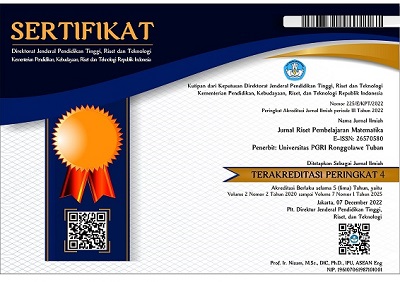EKSPLORASI ETNOMATEMATIKA PADA BATIK GEDOG
DOI:
https://doi.org/10.55719/jrpm.v3i1.259Keywords:
Batik Gedog, Etnomatematika, GeometriAbstract
Ethnomatematics is a study that contains mathematical ideas from traditional societies which are applied to certain societies which are practiced by cultural groups. One of the existing cultures in Tuban district is Gedog batik. Gedog batik ethnomatematics is a study that examines the application of mathematical concepts to Gedog batik. The purpose of this research is to examine how the mathematical concepts of the Gedog batik motif. The method used in this research is exploration with an ethnographic approach. The results showed that the Gedog batik motif contains mathematical elements, including the concepts of symmetry, transformation (reflection, translation, rotation) and congruence. By knowing the mathematical elements of Gedog batik, it is hoped that it can help understand mathematical concepts based on contextual problems that arise in the Gedog batik culture.
Downloads
References
Farida, Y., Susanto, S., & Setiawan, T. B. (2020). Etnomatematika Pada Pembuatan Batik Di Perusahaan Tatsaka Cluring Banyuwangi Sebagai Lembar Kerja Siswa. KadikmA. https://doi.org/10.19184/kdma.v11i1.17946
Gerdes, P. (1994). Reflection on ethnomatematics. For the Learning of Mathematics, 14(2), 19-21.
Nurhasanah, F., Kusumah, Y. S., & Sabandar, J. (2017). Concept of Triangle: Examples of Mathematical Abstraction in Two Different Contexts. International Journal on Emerging Mathematics Education. https://doi.org/10.12928/ijeme.v1i1.5782
Prahmana, R. C. I. (2017). Design Research (Teori dan Implementasinya: Suatu Pengantar). Jakarta: Rajawali Pers.
Prahmana, R. C. I., Zulkardi, & Hartono, Y. (2012). Learning multiplication using Indonesian traditional game in third grade. Journal on Mathematics Education. https://doi.org/10.22342/jme.3.2.1931.115-132
Sembiring, R. K. (2010). Pendidikan Matematika Realistik Indonesia (PMRI): Perkembangan dan tantangannya. Journal on Mathematics Education. https://doi.org/10.22342/jme.1.1.791.11-16
Setiawan, T. B., Wahyu, S., & Sunardi, S. (2018). Etnomatematika Pada Pura Mandara Giri Semeru Agung Sebagai Bahan Pembelajaran Matematika. KadikmA.
W, G. (2002). Metode Penelitian. In Journal of Materials Processing Technology.
Yudianto, E., Ambarwati, R., Safrida, L. N., Setiawan, T. B., & Cahyani, I. A. (2020). Etnomathematics on equipment of Kebo-Keboan Alas malang traditional ceremony. International Journal of Scientific and Technology Research.
Downloads
Published
How to Cite
Issue
Section
License
Penulis yang menerbitkan dengan jurnal ini menyetujui persyaratan berikut:
- Penulis mempertahankan hak cipta dan memberikan jurnal hak publikasi pertama dengan karya yang dilisensikan secara bersamaan di bawah Lisensi Internasional Creative Commons Attribution-ShareAlike 4.0 yang memungkinkan orang lain untuk berbagi karya dengan pengakuan kepenulisan karya dan publikasi awal di jurnal ini.
- Penulis dapat membuat pengaturan kontrak tambahan yang terpisah untuk distribusi non-eksklusif dari versi jurnal yang diterbitkan dari karya tersebut (misalnya, mempostingnya ke repositori institusional atau menerbitkannya dalam sebuah buku), dengan pengakuan publikasi awalnya di jurnal ini.
- Penulis diizinkan dan didorong untuk memposting karya mereka secara online (misalnya, di repositori institusional atau di situs web mereka) sebelum dan selama proses pengiriman, karena dapat menghasilkan pertukaran yang produktif, serta kutipan lebih awal dan lebih besar dari karya yang diterbitkan.









